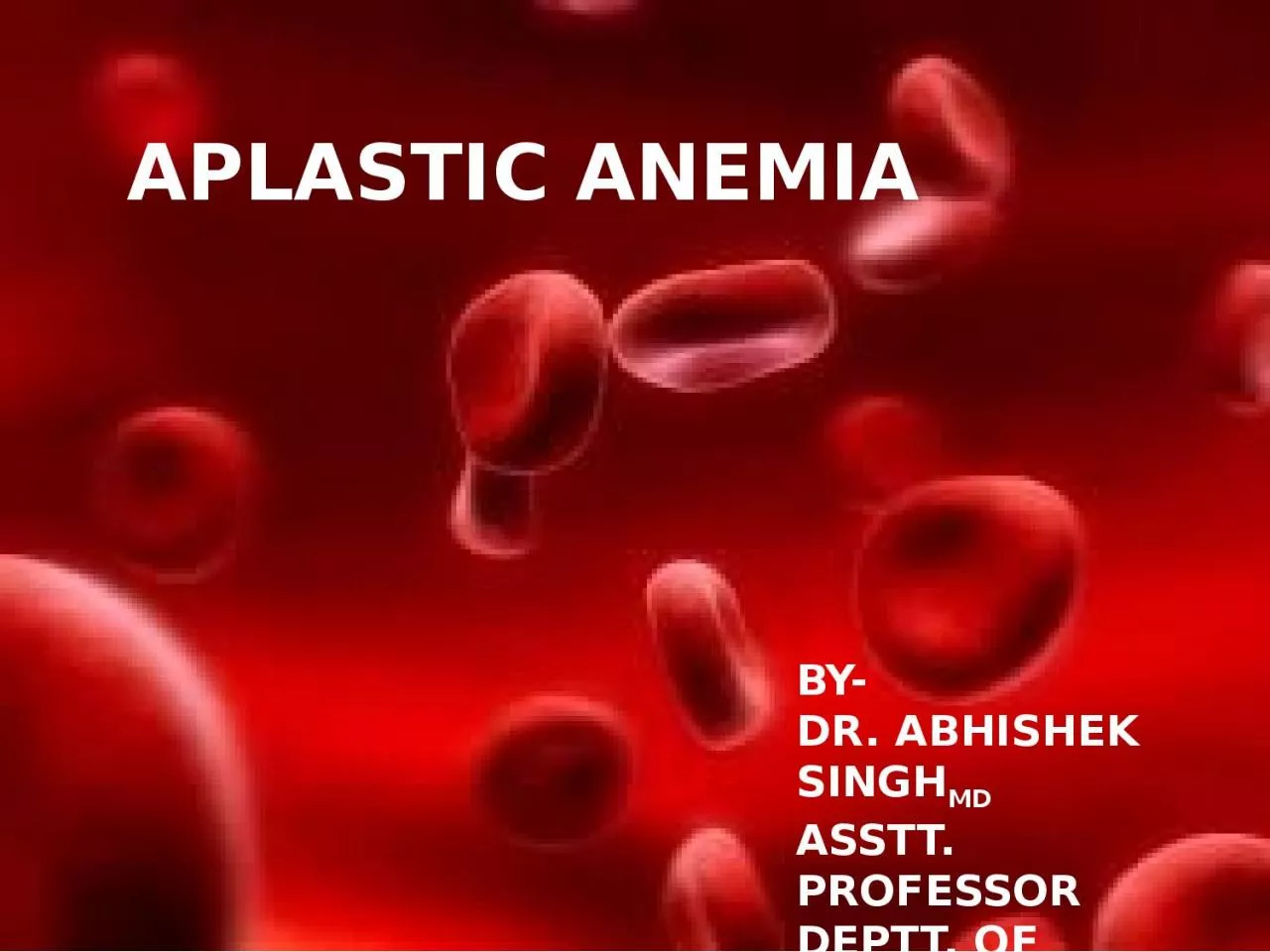

MD ASSTT PROFESSOR DEPTT OF MEDICINE Aplastic anemia is pancytopenia with bone marrow hypocellularity M en and women are affected with equal frequency A ge distribution is biphasic with the major peak in the teens and twenties and a second rise in older adults ID: 1035855
Download Presentation The PPT/PDF document "APLASTIC ANEMIA BY- DR. ABHISHEK SINGH" is the property of its rightful owner. Permission is granted to download and print the materials on this web site for personal, non-commercial use only, and to display it on your personal computer provided you do not modify the materials and that you retain all copyright notices contained in the materials. By downloading content from our website, you accept the terms of this agreement.
1. APLASTIC ANEMIABY-DR. ABHISHEK SINGHMDASSTT. PROFESSORDEPTT. OF MEDICINE
2. Aplastic anemia is pancytopenia with bone marrow hypocellularity.Men and women are affected with equal frequency.Age distribution is biphasic, with the major peak in the teens and twenties and a second rise in older adults.INTRODUCTION
3. CAUSESINHERITED-Fanconi's anemiaDyskeratosis congenitaShwachman-Diamond syndromeReticular dysgenesisAmegakaryocytic thrombocytopeniaFamilial aplastic anemiasPreleukemia (monosomy 7, etc.)Nonhematologic syndrome (Down, Dubowitz, Seckel)
4. CAUSESACQUIRED-RadiationDrugs and chemicalsViruses (non-A, non-B, non-C Hepatitis, EBV, Parvovirus B19, HIV-1)Immune diseases (Eosinophilic fasciitis, Thymoma, Hyperimmunoglobulinemia, Graft-versus-host disease)Paroxysmal nocturnal hemoglobinuria, PregnancyIdiopathic
5. RADIATIONMarrow aplasia can be an acute sequale to radiation.Nuclear accidents power plant workers, employees of hospitals, laboratories, and industry (food sterilization, metal radiography) are susceptible to it.MDS and leukemia, but probably not aplastic anemia, are late effects of radiation.CHEMICALSBenzene
6. DRUGS-Agents that regularly produce marrow depression as major toxicity in commonly employed doses or normal exposures: Cytotoxic drugs (alkylating agents, antimetabolites, antimitotics), some antibiotics.Agents that frequently but not inevitably produce marrow aplasia: BenzeneAgents associated with aplastic anemia but with a relatively low probability: Chloramphenicol, Anticonvulsants etc.
7. INFECTIONS-Hepatitis (non-A, non-B, non-C) is the most common preceding infection.Infectious mononucleosis & parvo virus B19 in some casesRarely other bacterial & viral infections
8. FANCONI’s ANEMIA-Autosomal recessive disorderChromosomes in Fanconi's anemia are peculiarly susceptible to DNA cross-linking agentThe most common, type A Fanconi's anemia, is due to a mutation in FANCA.manifests as congenital developmental anomalies (short stature, café au lait spots, and anomalies involving the thumb, radius, and genitourinary tract), progressive pancytopenia, and an increased risk of malignancy
9. DYSKERATOSIS CONGENITA-X- linked, in some cases autosomal dominantmutations in genes of the telomere repair complexCharacterized by Mucous membrane leukoplasia, dystrophic nails, reticular hyperpigmentation, and the development of aplastic anemia in childhood.SHWACHMAN- DIAMOND SYNDRME-compound heterozygous mutations in SBDSMarrow failure + Pancreatic insufficiency and malabsorption.
10. PATHOPHYSIOLOGYBone marrow failure results from severe damage to the hematopoietic cell compartment.There is replacement of the bone marrow by fat.An intrinsic stem cell defect exists for the constitutional aplastic anemiasExtrinsic damage to the marrow follows massive physical or chemical insults such as high doses of radiation and toxic chemicalsImmune mediators like Helper T cells, TNF, IFN-ϒ may be involved in the pathogenesis.
11. CLINICAL PRESENTATIONcan appear seeming abruptly or have a more insidious onset.Bleeding is the most common early symptom. Easy bruising, oozing from the gums, epistaxis, heavy menstrual flow, and sometimes petechie (massive hemorrhage is unusual)Symptoms of anemia are also frequent, including lassitude, weakness, shortness of breath, and a pounding sensation in the ears.Infection (due to leukopenia) is an unusual first symptom in aplastic anemia.
12. CLINICAL EXAMINATIONPetechiae and ecchymosesPallorRetinal hemorrhageLook for other features associated with inherited causesLymphadenopathy and splenomegaly are highly atypical of aplastic anemia.
13.
14. INVESTIGATIONSBLOOD-Smear shows large erythrocytes and a paucity of platelets and granulocytes.Reticulocytes are absent or few. BONE MARROW-fatty biopsy specimen may be grossly paleDilute smear“Dry tap" instead suggests fibrosis or myelophthisis
15.
16. TREATMENTHematopoietic growth factorsImmunosuppressionStem cell transplantationSupplementation of blood products and supportive care
17. Hematopoietic growth factors-Limited usefulnessStem cell transplantation-This is the best therapy for the younger patient with a fully histocompatible sibling donor.For allogeneic transplant from fully matched siblings, long-term survival rates for children are approximately 90%.
18. Immunosuppression-As most of patients lack suitable donor, it is the treatment of choice for them.ATG + Cyclosporine induces hematologic recovery in ≈ 60 % of cases.Relapse is frequent, usually after withdrawl of cyclosporine.MDS may develop in 15% of treated patients.
19. Increasing age and the severity of neutropenia are the most important factors weighing in the decision between transplant and immunosuppression in adults who have a matched family donor.Older patients do better with ATG and cyclosporine, whereas transplant is preferred if granulocytopenia is profound.
20.